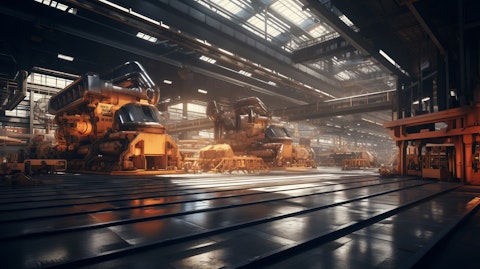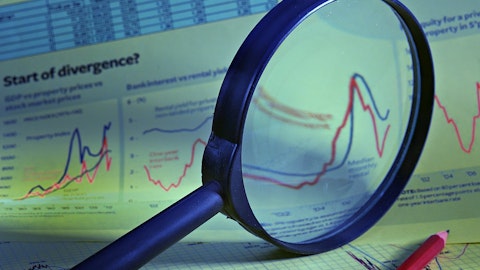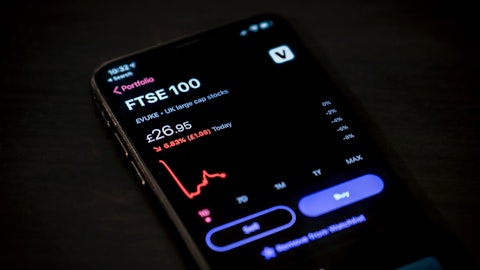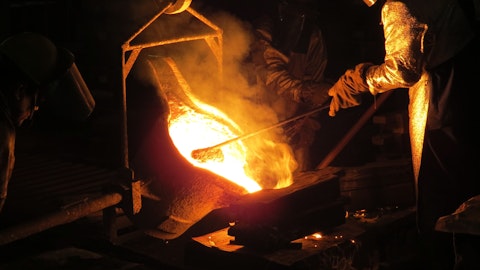Worthington Industries, Inc. (NYSE:WOR) Q3 2024 Earnings Call Transcript March 21, 2024
Worthington Industries, Inc. isn’t one of the 30 most popular stocks among hedge funds at the end of the third quarter (see the details here).
Operator: Hello, and welcome to the Worthington Enterprises Third Quarter Fiscal 2024 Earnings Conference Call. All participants will be in a listen-only mode, until the question-and-answer session of the call. This conference is being recorded at the request of Worthington Enterprises. If anyone objects, you may disconnect at this time. I’d now like to introduce Marcus Rogier, Treasurer and Investor Relations Officer. Mr. Rogier, you may begin.
Marcus Rogier: Thank you, Sarah. Good morning, everyone, and welcome to Worthington Enterprises third quarter fiscal 2024 earnings call. On our call today, we have Andy Rose, Worthington’s President and Chief Executive Officer; and Joe Hayek, Worthington’s Chief Financial and Operations Officer. Before we get started, I’d like to note that certain statements made today are forward-looking within the meaning of the 1995 Private Securities Litigation Reform Act. These statements are subject to risk and uncertainties that could cause actual results to differ from those suggested. We issued our earnings release yesterday after the market close. Please refer to it for more detail on those factors that could cause actual results to differ materially.
In addition, our discussion today will include non-GAAP financial measures. A reconciliation of these measures with the most appropriate comparable GAAP measure is included in the earnings press release, which is available on our investor relations website. At this point, I will turn the call over to Andy for opening remarks.
Andy Rose: Thank you, Marcus, and good morning. I want to welcome everyone to our first full quarter as Worthington Enterprises. We’ve hit the ground running and are already delivering solid results as evidenced by our adjusted EBITDA of $67 million and adjusted earnings per share of $0.80. While there are a number of one-time items mostly related to the separation which Joe will run through, we are proud of our people and their ability to stay focused over the past year. I remain as excited as ever about Worthington Enterprises and our opportunity for long-term value creation. Our consumer products, building products, and sustainable energy businesses represent a strong franchise of market leading products and brands that will enable people to live safer, healthier and more expressive lives.
We have a unique and proven growth platform that has been purposefully created using deep industry expertise, a performance driven people first culture and the best employees in the world, and a thoughtful long term investment strategy. We find the best product opportunities, invest to drive value at scale and build sustainable advantage through safety, quality, service and a reputation for doing the right thing for our customers. The Worthington business system of transformation, innovation and M&A is well entrenched and enables us to grow faster and deliver on our number one goal of generating attractive returns for our shareholders. Our transformation playbook now in its third evolution continues to provide a systematic approach for improving our commercial operations and supply chain functions, enhancing the top and bottom line for our businesses.
Innovation is now a deeply embedded competency that we put to work across our business from process innovation to new product development, which we intend to make best-in-class with a pipeline that will distinguish us from competitors and provide enhanced value to our customers. And finally, our expertise in strategic M&A will help us drive growth and higher returns as we add new products, new brands and consolidate markets. To that end, we recently welcomed HALO products into our portfolio of brands, offering an innovative collection of pizza ovens, pellet grills and griddles that is disrupting the outdoor living space. This acquisition immediately accelerates years of product development for us with its lean and capable team. And while its early days, the company is already benefiting from our relationships with major retailers and gaining greater access to our capital and expertise to drive accelerated direct-to-consumer marketing and sales.
This is a nice example of the Worthington business system at work and how we build market leading businesses. We’re disciplined stewards of capital, not only making new investments to deliver long term value creation, but also redeploying capital in situations where we can earn a better return. We’re off to a good start in our first quarter as Worthington Enterprises. And Joe will now walk you through the numbers.
Joseph Hayek: Thank you, Andy, and good morning, everyone. Q3 was our first standalone quarter as Worthington Enterprises, and given the recent business separation, we’ve recast our historical income statement and balance sheets for periods prior to December 1, 2023 to reflect Worthington Steel as discontinued operations. As a result, there is and will be some noise in our reported financials, but we will attempt to call out unique items and adjustments to facilitate year-over-year comparability of the business performance. In Q3, we reported GAAP earnings from continuing operations of $0.44 a share versus $0.60 in the prior year. There were several unique items that impacted our quarterly results, including the following. The current quarter was negatively impacted by one-time discrete tax charges of $9 million or $0.18 a share, all related to the business separation.
In addition, we incurred pre-tax expense of $3 million, or $0.05 a share related to the separation in the current quarter. We do not anticipate having additional separation costs in future quarters. We also took advantage of the current interest rate environment to annuitize our only remaining legacy defined benefit pension plan, which resulted in a non-cash pre-tax charge of $8 million or $0.12 a share. We incurred modest restructuring charges, which negatively impacted earnings by a $0.01 per share in the current quarter. And lastly, results in the prior year quarter were negatively impacted by $0.21 a share due to several unique items, the largest being corporate costs that were eliminated at the time of separation along with smaller restructuring and other non-recurring items.

Excluding these items, we generated adjusted earnings from continuing operations of $0.80 per share in the current year quarter compared to $0.81 a share in Q3 of last year. Additionally, our building products business recorded a one-time pre-tax charge of $2 million, or $0.03 a share in the current quarter, related to a lower of cost or net realizable value adjustment on propane tanks that were imported from a third-party supplier in Europe. The LCM was primarily driven by higher than expected transportation costs for those tanks. Consolidated net sales in the quarter of $317 million decreased 8.5% from $346 million in the prior year. The decrease was driven by lower sales in building products, which experienced an unfavorable product mix, and slightly lower volumes during the quarter, partially offset by slight increases in sales within consumer products and sustainable energy solutions, which both benefited from increased volumes.
Gross profit for the quarter decreased to $73 million from $79 million in Q3 a year ago, while our gross margin increased to 23.1% from 22.8%. Including the $2 million charge in building products, our adjusted EBITDA in Q3 was $67 million, down from $70 million in Q3 of last year. And our trailing 12 months adjusted EBITDA is now $279 million, and our trailing 12 months adjusted EBITDA margin is 21.5%. With respect to cash flows in our balance sheet, cash flow from operations was $50 million in the quarter and free cash flow was $40 million that would have been higher if not for $13 million in cash outflows related to the business separation. During the quarter, we invested $10 million on capital projects, which included $5 million related to our previously mentioned facility modernization projects.
We also spent $9 million to acquire an 80% interest in an affiliate of HALO products group and paid $16 million in dividends, which represented the larger pre-separation Worthington Industries’ dividend that was paid in December. We also received $40 million in dividends from our unconsolidated JVs during the quarter, a 93% cash conversion rate on that equity income. Looking at our balance sheet and liquidity position. We ended the quarter with an exceptionally strong balance sheet, $298 million of long term funded debt carrying an average interest rate of 3.6%, combined with $227 million in cash that is yielding around 5%. We continue to operate with extremely low leverage, ending the quarter with a net debt to trailing EBITDA leverage ratio of about a quarter turn, and we’re well positioned for the future with ample liquidity having a $500 million undrawn bank credit facility.
Yesterday, the Worthington Enterprises Board declared a dividend of $0.16 per share for the quarter, which is approximately $8 million and will be payable in June of 2024. We’ll now spend a few minutes on each of the businesses. In consumer products, net sales in Q3 were $133 million, up slightly from $131 million a year ago. The increase was a result of higher volumes, which were partially offset by lower average selling prices. Adjusted EBITDA for the consumer business was $26 million and adjusted EBITDA margin was 19.3% in Q3 compared to $21 million and 16.1% last year. We experienced a strong sequential improvement with volumes increasing 19% compared to Q2 as a result of some storm and weather related demand as well as recent market share gains at Level 5.
Though some demand may have been pulled from Q4 into Q3, we’re cautiously optimistic heading into the spring as people begin to enjoy the outdoors more frequently and begin to take on more repaired and remodeled projects. During the quarter, as Andy mentioned, the consumer business acquired an 80% controlling interest in an affiliate of HALO Products Group for approximately $9 million. HALO is an innovative asset-light provider of tech enabled products including pizza ovens, pellet grills, griddles and accessories that complement our other leading outdoor living brands like Coleman portable propane tanks and Bernzomatic torches, fuel and accessories. HALO is a natural match with these products and creates a powerful combination. While HALO is small today, with 2023 revenues of $7 million, which was primarily direct-to-consumer, we intend to leverage our strong relationships with channel partners to help further grow and scale the brand.
We’re excited to have HALO as part of our consumer business and we welcome that talented team to Worthington. Building Products generated net sales of $148 million in Q3, down 19% from $184 million a year ago. The decrease was driven by a less favorable product mix, lower average selling prices and lower volumes, especially in the large format heating end market which continued to see destocking. Building Products generated adjusted EBITDA of $53 million for the quarter and adjusted EBITDA margin was 35.8% compared to $58 million and 31.6% in Q3 of last year. Results in the current quarter were negatively impacted by the $2 million due to the LCM on imported tanks that I mentioned earlier. The destocking we continue to see in our heating end market, should run its course by the summer and we’re optimistic that that demand will return to more seasonally normal levels thereafter.
Additionally, our water business continued to show growth in revenues and margins in Q3 as the initiatives we put in place in early 2024 are having a positive impact. During Q3, the water team also continued the launch of our Amtrol Titan well tank with two new sizes. The Titan is a patented composite tank that combines the strength of steel, and the advantages of high tech composites providing superior impact resistance and UV protection. WAVE delivered very strong results, contributing equity earnings of $26 million in the quarter, up from $19 million a year ago. The team at WAVE continues to focus on refining and enhancing their value proposition to customers, and they saw both volume and margin improvements in the quarter. ClarkDietrich also continued to perform very well and contributed $18 million in equity income for the quarter.
Though their results were down $1 million compared to the prior year quarter, they were up $4 million sequentially from Q2. The ClarkDietrich team is leveraging its national presence and benefited from higher volumes in Q3, which was offset by some margin compression. In sustainable energy solutions, net sales in Q3 of $35 million were up 11%, or $4 million from the prior year, primarily due to higher volumes, which were partially offset by lower average selling prices and an unfavorable product mix. SES reported an adjusted EBITDA loss of $3 million in the current quarter compared to breakeven results in the prior year, due to lower gross margins and several one-time expenses. In the current environment, the SES team continues to focus on near term cost controls and long term investments as they attempt to balance current market conditions with the exceptional growth opportunities that we believe will materialize as the hydrogen and CNG ecosystems grow.
During the quarter, the team had success getting additional new products certified and customer ready, and quoting activity continues to improve, which should ultimately result in a better demand environment. At this point, we’re happy to take any questions that people might have.
See also Hedge Funds and Insiders Are Buying These 10 Stocks and 30 Countries With the Worst Air Pollution.
Q&A Session
Follow Worthington Enterprises Inc. (NYSE:WOR)
Follow Worthington Enterprises Inc. (NYSE:WOR)
Operator: Thank you. [Operator Instructions] Your first question comes from the line of Daniel Moore with CJS Securities. Your line is open.
Daniel Moore: Thank you. Good morning, Andy. Good morning, Joe. Thanks for taking the questions.
Andy Rose: Good morning, Dan.
Joseph Hayek: Good morning.
Daniel Moore: Maybe start with where we finished off there at the tail end of the comments on the JVs. What can you tell us about demand and activity levels both at WAVE and ClarkDietrich on a forward looking basis? I know you don’t quote backlog, but how would you describe the level of new business coming into the pipeline relative to maybe six months ago or this time last year?
Andy Rose: Yeah. It’s a fair question. I think the markets have evolved in that construction space. For instance, WAVE, whose mix of repair and remodel versus new is typically 65% to 70% repair and remodel, it’s higher now. In part because the new spend is down. Their mix of end markets, our estimates of those, at least. It’s still kind of tough letting in commercial buildings that are office centric, but also in commercial, you have lots of other things, including data centers, which is showing good growth, but 70% of their end markets we believe are non-commercial, right. They’re a mix of healthcare, education, retail, and sort of transportation projects. And so volumes seem steady there, ClarkDietrich there’s a little bit of a different mix there, slightly more new there, they’re broadening the types of projects they’re working on, not because they’re super focused on X, Y or Z, but just because it’s where construction is happening.
And so, we think that as construction and activity kind of came down, it seems to be more sort of flat, now, it’s not continuing to go down, at least right this minute, nor is it going straight up. I think the architectural billings index, that came out yesterday or the day before was 49.5%, which is just below 50%. It was 45% the last few months. It was — I think the last time it was at 50% was April of last year. That’s a good sign. I think we mentioned in December that the activity level, not the billings, but activity with architects had started to pick back up, which is typically a precursor to billings. But that also takes, when you see a good AVI, that takes 12 months to 24 months to show up in somebody like ours’s revenue or ClarkDietrich or WAVE.
And so, we generally still feel very good about the spaces that they’re in kind of mid to longer term, I call it a bit murky out there in the short term.
Daniel Moore: Very helpful. Maybe switching gears, still early days, obviously, but maybe just update us on progress in the direct-to-consumer channel. Obviously, a key capability of Level 5, now you’ve tacked on HALO any tangible examples of products you’re now offering or plan to offer DTC that perhaps you didn’t historically and just progress in general in that channel?
Andy Rose: Yeah. I think, Dan, the short answer is that when we acquired Level 5, we acquired not only a new set of products, but we acquired a capability. And it really helped us — really helped open up our eyes in terms of the direct-to-consumer channel. And so the team and consumer really is looking across the product line to figure out which products we think we can sell into that channel. And HALO — excuse me, HALO is another example of a product that is sold direct-to-consumer only right now. And so that’s part of the overarching strategy, now, when we either develop new products or acquire new products is looking across all the channels direct-to-consumer and using and leveraging big box retail relationships to sort of maximize the opportunity for those products. So I wouldn’t say there’s one opportunity there’s probably a bunch of opportunities where we’re looking to sort of leverage those capabilities.
Daniel Moore: Helpful. Last one for me. I’ll jump out. I think you mentioned, put a little bit of potential pull forward in demand in the consumer side from Q4 to Q3. Any details there, or can you quantify that at all? Thanks again for the help, and congrats on a really solid quarter.
Andy Rose: All right. Thank you. And yeah, sure. The consumer business, particularly our camping gas cylinders to a lesser extent, the torches that go with those, there is a little bit of weather related spike demand from time-to-time. And so if you remember in January, the polar vortex and then the storms that were kind of back to back across the country really created a need because those products are sometimes used as emergency heat sources and they’re certainly used to repair pipes that break. If you — not to become a weather man, but if you get past those two events, the weather in the winter has been relatively benign. And so we feel really good about the spring and the season and how we’re positioned and how we’ve helped our retail customers get to where they want to be and to where they’ll be able to best serve their own customers.
But sometimes that spike demand can really move things from a month to a month, that’s the reason for kind of some of our — I’ll call it cautious optimism in Q4.
Joseph Hayek: Yeah. The storms are incremental demand. The question and it’s hard to predict is was there pull forward or not? And the answer is, if our retailers are fully prepared and fully stocked, there may be a little bit of pull forward, but it’s again, it’s not an exact science in terms of estimating it.




